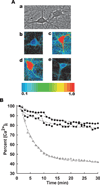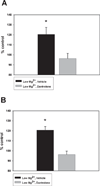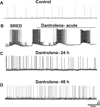Dantrolene inhibits the calcium plateau and prevents the development of spontaneous recurrent epileptiform discharges following in vitro status epilepticus
- PMID: 20597971
- PMCID: PMC3197238
- DOI: 10.1111/j.1460-9568.2010.07262.x
Dantrolene inhibits the calcium plateau and prevents the development of spontaneous recurrent epileptiform discharges following in vitro status epilepticus
Abstract
Status epilepticus is a clinical emergency that can lead to the development of acquired epilepsy following neuronal injury. Understanding the pathophysiological changes that occur between the injury itself and the expression of epilepsy is important in the development of new therapeutics to prevent epileptogenesis. Currently, no anti-epileptogenic agents exist; thus, the ability to treat an individual immediately after status epilepticus to prevent the ultimate development of epilepsy remains an important clinical challenge. In the Sprague-Dawley rat pilocarpine model of status epilepticus-induced acquired epilepsy, intracellular calcium has been shown to increase in hippocampal neurons during status epilepticus and remain elevated well past the duration of the injury in those animals that develop epilepsy. This study aimed to determine if such changes in calcium dynamics exist in the hippocampal culture model of status epilepticus-induced acquired epilepsy and, if so, to study whether manipulating the calcium plateau after status epilepticus would prevent epileptogenesis. The in vitro status epilepticus model resembled the in vivo model in terms of elevations in neuronal calcium concentrations that were maintained well past the duration of the injury. When used following in vitro status epilepticus, dantrolene, a ryanodine receptor inhibitor, but not the N-methyl-D-aspartic acid channel blocker MK-801 inhibited the elevations in intracellular calcium, decreased neuronal death and prevented the expression of spontaneous recurrent epileptiform discharges, the in vitro correlate of epilepsy. These findings offer potential for a novel treatment to prevent the development of epileptiform discharges following brain injuries.
Figures






Similar articles
-
Novel therapeutics for treating organophosphate-induced status epilepticus co-morbidities, based on changes in calcium homeostasis.Neurobiol Dis. 2020 Jan;133:104418. doi: 10.1016/j.nbd.2019.03.006. Epub 2019 Mar 12. Neurobiol Dis. 2020. PMID: 30872159 Free PMC article. Review.
-
N-methyl-D-aspartate receptor blockade after status epilepticus protects against limbic brain damage but not against epilepsy in the kainate model of temporal lobe epilepsy.Neuroscience. 2003;118(3):727-40. doi: 10.1016/s0306-4522(03)00027-7. Neuroscience. 2003. PMID: 12710980
-
Ryanodine receptors drive neuronal loss and regulate synaptic proteins during epileptogenesis.Exp Neurol. 2020 May;327:113213. doi: 10.1016/j.expneurol.2020.113213. Epub 2020 Jan 24. Exp Neurol. 2020. PMID: 31987836
-
Carisbamate prevents the development and expression of spontaneous recurrent epileptiform discharges and is neuroprotective in cultured hippocampal neurons.Epilepsia. 2008 Oct;49(10):1795-802. doi: 10.1111/j.1528-1167.2008.01667.x. Epub 2008 May 20. Epilepsia. 2008. PMID: 18494784 Free PMC article.
-
Development of the calcium plateau following status epilepticus: role of calcium in epileptogenesis.Expert Rev Neurother. 2009 Jun;9(6):813-24. doi: 10.1586/ern.09.21. Expert Rev Neurother. 2009. PMID: 19496685 Free PMC article. Review.
Cited by
-
Pharmacological blockade of the calcium plateau provides neuroprotection following organophosphate paraoxon induced status epilepticus in rats.Neurotoxicol Teratol. 2016 Jul-Aug;56:81-86. doi: 10.1016/j.ntt.2016.05.002. Epub 2016 May 17. Neurotoxicol Teratol. 2016. PMID: 27224207 Free PMC article.
-
Novel therapeutics for treating organophosphate-induced status epilepticus co-morbidities, based on changes in calcium homeostasis.Neurobiol Dis. 2020 Jan;133:104418. doi: 10.1016/j.nbd.2019.03.006. Epub 2019 Mar 12. Neurobiol Dis. 2020. PMID: 30872159 Free PMC article. Review.
-
Hypothermia Reduces Mortality, Prevents the Calcium Plateau, and Is Neuroprotective Following Status Epilepticus in Rats.Front Neurol. 2018 Jun 11;9:438. doi: 10.3389/fneur.2018.00438. eCollection 2018. Front Neurol. 2018. PMID: 29942282 Free PMC article.
-
Purinergic agonists increase [Ca2+]i in rat conjunctival goblet cells through ryanodine receptor type 3.Am J Physiol Cell Physiol. 2024 Sep 1;327(3):C830-C843. doi: 10.1152/ajpcell.00291.2024. Epub 2024 Aug 5. Am J Physiol Cell Physiol. 2024. PMID: 39099424 Free PMC article.
-
Role of the calcium plateau in neuronal injury and behavioral morbidities following organophosphate intoxication.Ann N Y Acad Sci. 2016 Jun;1374(1):176-83. doi: 10.1111/nyas.13122. Epub 2016 Jun 21. Ann N Y Acad Sci. 2016. PMID: 27327161 Free PMC article. Review.
References
-
- Bardo S, Cavazzini MG, Emptage N. The role of the endoplasmic reticulum Ca2+ store in the plasticity of central neurons. Trends Pharmacol. Sci. 2006;27:78–84. - PubMed
-
- DeGiorgio CM, Tomiyasu U, Gott PS, Treiman DM. Hippocampal pyramidal cell loss in human status epilepticus. Epilepsia. 1992;33:23–27. - PubMed
Publication types
MeSH terms
Substances
Grants and funding
LinkOut - more resources
Full Text Sources
Miscellaneous

